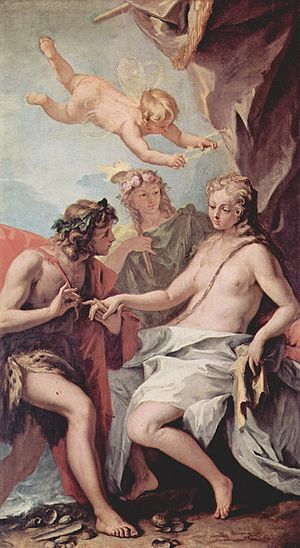Catullus 64

Catullus 64 is an epyllion or "little epic" poem written by Catullus. Catullus' longest poem, it retains his famed linguistic witticisms while expressing an appropriately epic tone.
Though ostensibly concerning itself with the marriage of Peleus and the sea-nymph Thetis (parents of the famed Greek hero Achilles), a sizeable portion of the poem's lines are devoted to the desertion of Ariadne by the legendary Theseus. Although the poem implies that Theseus and Ariadne were in love, in reality the text never explicitly states that Theseus even looked at Ariadne. Told through ecphrasis, or the depiction of events on inanimate objects, the bulk of the poem details Ariadne's agonized solace. Her impassioned vituperations and eventual discovery by the wine-god Bacchus are some of the included plot events.
The meter of the poem is dactylic hexameter, the meter of epic poetry, such as Homer's Iliad and Odyssey and Virgil's Aeneid.
Bibliography
- DeBrohun, J (1999). "Ariadne and the whirlwind of fate: figures of confusion in Catullus 64.149-57". Classical Philology. 94 (4): 419–430. doi:10.1086/449456.
- Faber, Riemer (1998). "Vestis...variata (Catullus 64, 50-51) and the Language of Poetic Description". Mnemosyne. 51 (2): 210–215. doi:10.1163/1568525982611641.
- Tathan, G (1990). "Ariadne's mitra: a note on Catullus 64.1-4". Classical Quarterly. 40 (2): 560–561. doi:10.1017/S0009838800043196.
- Thomas, R (1983). "Callimachus, the Victoria Berenices, and Roman Poetry". Classical Quarterly. 33: 92–113. doi:10.1017/S0009838800034327.
- Duban, Jeffrey (1980). "Verbal Links and Imagistic Undercurrent in Catullus 64". Latomus. 39 (4): 778–800. doi:10.1086/449456.
- Konstan, D (1977). Catullus' Indictment of Rome: The Meaning of Catullus 64. Amsterdam: Adolf M. Hakkert. ISBN 978-90-256-0742-5.
- Putnam, MCJ (1961). "The Art of C. 64". Harvard Studies in Classical Philology. 65. Harvard Studies in Classical Philology, Vol. 65: 166–205. doi:10.2307/310836. JSTOR 310836.
